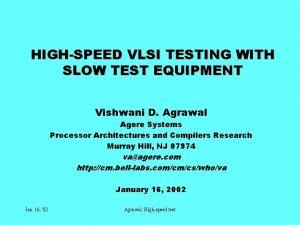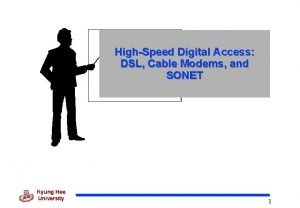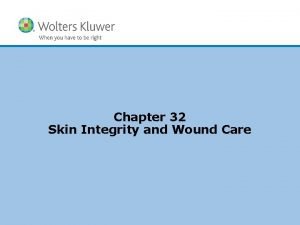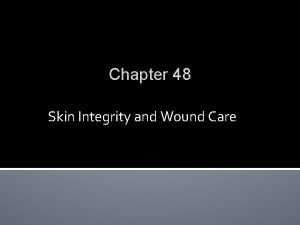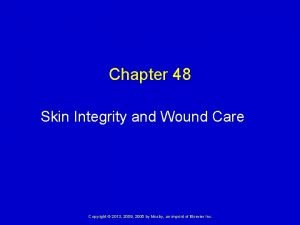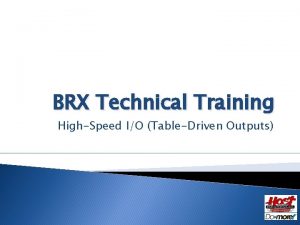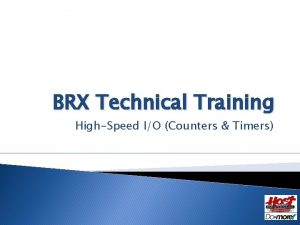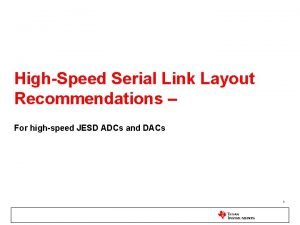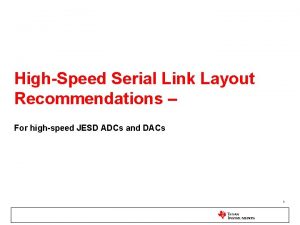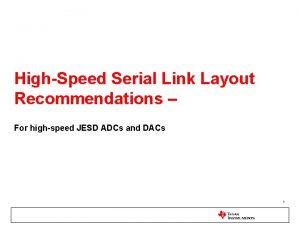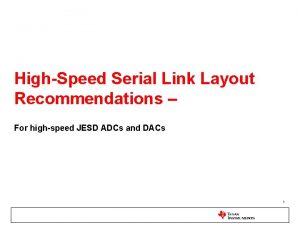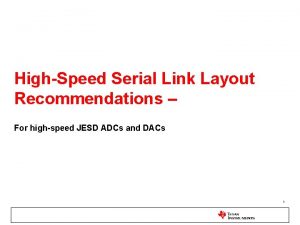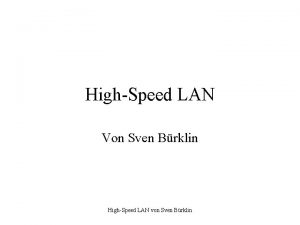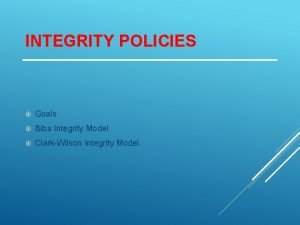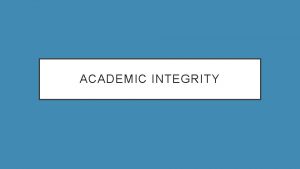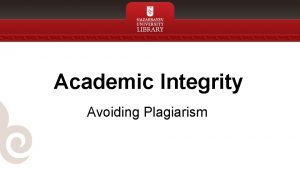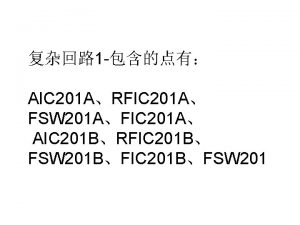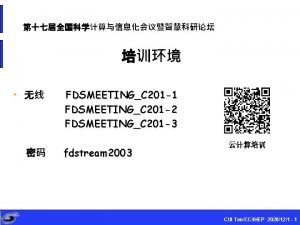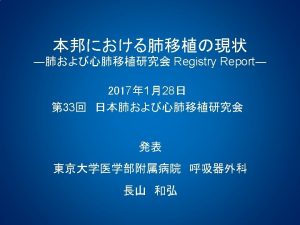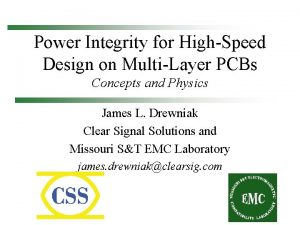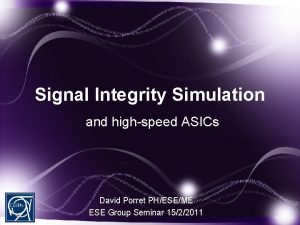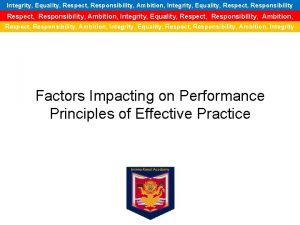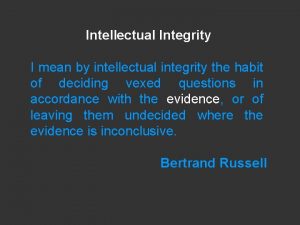EE 201 C Chapter 7 Integrity for HighSpeed

![High-speed Links are Everywhere Backbone Router Rack PC or Console EDA/UCLA [Sredojevic: ICCAD’ 08] High-speed Links are Everywhere Backbone Router Rack PC or Console EDA/UCLA [Sredojevic: ICCAD’ 08]](https://slidetodoc.com/presentation_image_h/f21aec432f28f4a55316c53f83be3e94/image-2.jpg)




































- Slides: 38

EE 201 C Chapter 7 Integrity for High-Speed Signaling Prof. Lei He Electrical Engineering Department University of California, Los Angeles URL: eda. ee. ucla. edu Email: lhe@ee. ucla. edu EDA/UCLA 1
![Highspeed Links are Everywhere Backbone Router Rack PC or Console EDAUCLA Sredojevic ICCAD 08 High-speed Links are Everywhere Backbone Router Rack PC or Console EDA/UCLA [Sredojevic: ICCAD’ 08]](https://slidetodoc.com/presentation_image_h/f21aec432f28f4a55316c53f83be3e94/image-2.jpg)
High-speed Links are Everywhere Backbone Router Rack PC or Console EDA/UCLA [Sredojevic: ICCAD’ 08] 2

High-Speed Links: Applications • Chip-to-chip signaling • Computers, games: SDRAM(DDR, DDR 2) 100 - 700 MHZ, RDRAM 800 -1600 MHz, DDR 3 800 -1600 MHz, DDR 4 1. 6 -3. 2 GHz, XDR DRAM 3. 2 -6. 4 GHz • Board-to-board • Computers: Peripherals- PCI (66 -133 -400 MHz), PCIe (250 M-500 M-1 GHz), Infiniband (2. 5 Gb/s) • Networks • LAN: Fast Ethernet, Gigabit Ethernet, 10 G Ethernet • WAN: OC-12 (625 MHz), OC-192(12. 5 GHz) • Routers: 625 Mb/s – 2. 5 Gb/s EDA/UCLA 3

Outline • Link Design Basics • Signal Integrity • High Speed Signaling Architectures • Equalization EDA/UCLA 4

Noise • Signals may be corrupted from many sources • Inter-symbol interference (ISI) • Frequency-dependent attenuation (dispersion) • Reflection • Oscillation • Crosstalk • Power supply noise • Real noise • Thermal and shot noise • Parameter variation • Noise measure • Eye diagram • Timing jitter • Amplitude noise EDA/UCLA 5

Inter-Symbol Interference • A signal interfering with itself • Ideally a transmission system is time invariant • No history of previous bits • In reality, the state of the system is affected by previous bits • Signals that don’t reach the rails by the end of cycle • Signal’s transition time is limited by channel bandwidth • Reflections on the transmission lines • Magnitude and phase of excited resonances EDA/UCLA 6

ISI - Dispersion • Frequency-dependent attenuation • In general, channel is low pass • Our nice short pulse gets spread out • Example: a 101 pattern EDA/UCLA 7

ISI - Reflection • Reflections of previous bits travel up and down transmission lines • A mismatch of δ gives (to the first order) a reflection of ρ EDA/UCLA 8

ISI - Resonances • Oscillations are excited by signal transitions and may interfere with later transitions • Excitation of resonant circuits is reduced with longer transition times • Slower edge has less high frequency spectral content • Resistance damps oscillation EDA/UCLA 9

Crosstalk • Crosstalk is the coupling of energy from one line to another via: • Mutual capacitance (electric field) • Mutual inductance (magnetic field) • One signal interfering with another signal Mutual Inductance, Lm Mutual Capacitance, Cm Zo Zo far Cm Lm near Zs Zo EDA/UCLA near Zs Zo 10

Crosstalk Induced Noise • The mutual inductance will induce current on the victim line opposite of the driving current (Lenz’s Law) • The mutual capacitance will pass current through the mutual capacitance that flows in both directions on the victim line Zo Zo far ICm near Zs Zo EDA/UCLA ILm Lm near Zs Zo 11

Voltage Profile of Coupled Noise • Near end crosstalk is always positive • Currents from Lm and Cm always add and flow into the node • For PCB’s, the far end crosstalk is “usually” negative • Current due to Lm larger than current due to Cm • Note that far and crosstalk can be positive Zo Zo Far End Driven Line Un-driven Line “victim” Zs Driver EDA/UCLA Near End Zo 12

Graphical Explanation Time = 0 Near end crosstalk pulse at T=0 (Inear) ~Tr V Zo Time= 1/2 TD Near end crosstalk TD Far end crosstalk pulse at T=0 (Ifar) ~Tr 2 TD V Zo far end crosstalk Zo Time= TD V Zo Zo Far end of current terminated at T=TD Time = 2 TD V Zo Near end current terminated at T=2 TD Zo EDA/UCLA 13

Power Supply Noise • The power supply network has parasitic elements • On-chip: resistive • Off-chip: inductive • Current draw across these elements induces a noise voltage: • Instantaneous current is what matters • May be many times the DC current • 10 W chip draws 4 A at 2. 5 V • Peak current may be 10 -20 A EDA/UCLA 14

Simultaneous Switching Outputs (SSO) • When several outputs switch simultaneously, significant current is drawn from the supply or sent into ground • Supply connections have inductance • SSO currents produce a voltage drop across these inductances • On-chip, the VDD to VSS voltage difference decreases • Effect grows with number of drivers switching • Quadratic with the inverse of transition time • Between chips, the drops across VSS inductances can effect driver timing and shift the receiver threshold EDA/UCLA 15

Other Noise Sources • Alpha particles • 5 Me. V particle injects 730 f. C of charge into substrate • One node typically collects less than 50 f. C • Thermal and shot noise • Proportional to bandwidth – typically in the u. V • Parameter mismatch • VT and β have deviation proportional to 1/sqrt(WL) • Systematic variations depend on layout EDA/UCLA 16

Eye Diagram This is a “ 1” This is a “ 0” Eye – space between 1 and 0 With voltage noise With timing noise With both!! EDA/UCLA 17

Eye Diagram (cont’d) • Standard measure for signaling • Synchronized superposition of all possible realizations of the signal viewed within a particular interval • Timing jitter • Deviation of the zero-crossing from its ideal occurrence time • Amplitude noise • Set by signal-to-noise ratio (SNR) • The amount of noise at the sampling time EDA/UCLA 18

Outline • Link Design Basics • Signal Integrity • High Speed Signaling Architectures • Equalization EDA/UCLA 19

Signaling – Main Idea • A good signaling system isolates the signal from noise rather than trying to overpower the noise • Crosstalk • Terminate both ends, use homogeneous media • ISI • Matched terminations, no resonators, rise-time control • Power supply noise • Avoid coupling into signal or reference • Differential signaling • Current mode • stable reference EDA/UCLA 20

Signaling Architecture Tradeoffs • Signal modulation • PAM (Pulse-amplitude modulation) • Pulsed (Return-to-Zero, RZ) signaling • Binary (ex: NRZ) or Multiple-level signaling (MLS) • Uni-directional or Bidirectional • Time-multiplexed bidirectional or simultaneous bidir. • Single-ended or differential • Current mode or voltage mode • Bus or single-trace • Point-to-point or multi-drop EDA/UCLA 21

Example System - Trade-offs EDA/UCLA 22

Voltage Mode vs Current Mode • Main differences are • Ease of control and generation • Much easier to generate a small current than a small voltage • Coupling of supply noise • 50% of supply noise shows up on the data line in the matched voltage mode; potentially much less in a high-Z current-mode driver • Generation of high-Z switches easier than controlled-Z switches EDA/UCLA 23

Single-ended vs Differential • Single-ended signaling • Differential signaling • compare to shared • compare between two • • • reference Often used with a bus Issues • • EDA/UCLA Generates SSO noise How to make reference How to quiet reference Crosstalk cannot be made common-mode lines Noise immunity • Many noise sources become common mode • Issues • Differential must run > 2 x as fast as singleended to make sense • Otherwise, powerx 2, pinsx 2 24

Binary vs Multiple-level (4 -PAM) • Binary (NRZ) is 2 -PAM • Use 2 -levels to send onebit per symbol • Signaling rate = 2 x. Nyquist EDA/UCLA • 4 -PAM uses 4 -levels to send 2 bits per symbol • Each level has 2 bit value • Signaling rate = 4 x. Nyquist 25

When Does 4 -PAM Make Sense? EDA/UCLA 26

Simultaneous Bidirectional Signaling • Wires can transmit waves in both directions • It seems a shame to only use one direction at a time • Simultaneous Bidirectional Signaling • Transmit waves in both directions at the same time • Waveform on wire is superposition of forward and reverse traveling wave • Subtract transmitted wave at each end to recover received wave • There are 3 -levels on the line but it’s still 2 -level signaling • Much more sensitive to reflections and crosstalk EDA/UCLA 27

Output Drivers • Single-ended • SSTL (Stub Series Terminated Logic) • RSL (Rambus Signaling Logic) • GTL (Gunning Transceiver Logic) • Differential • LVDS (Low Voltage Differential Signaling) • CML (Current Mode Logic) EDA/UCLA 28

SSTL • Center-terminated, push-pull • Very flexible termination • Allows double, single, or no • termination But source term slows edge rates & limits speed • Very simple • Driver can be simple inverter • Receiver can be simple inverter • But PVT varying output driver means reflections EDA/UCLA 29

RSL • Open drain current-source driver • Current-control to keep constant I over PVT • Slew-rate control to keep rate low enough to avoid • • overshoot & ringing Low-swing with reference Relatively expensive and complicated EDA/UCLA 30

GTL • Just like Rambus” • But… output driver goes linear • No current-control EDA/UCLA 31

LVDS • Differential • Eliminates non-common mode reference noise • Also (ideally) keeps current at driver constant • Termination at the RX on-chip or off-chip • No references, can ship across cable • Requires very wide CM range from RX • Unterminated at driver; reflections occur from • discontinuities Timing of driver push-pull ckt can be a challenge EDA/UCLA 32

CML • Open-drain • High common-mode keeps saturation • DC or AC coupled • AC-coupling requires 8 b 10 b coding • Termination • DC-term: Better control of CM than LVDS • Double-terminated • Minimize reflections off driver • Driver and receiver both see 25Ω • More power • 4 x LVDS just from 100 Ω -> 25 Ω termination EDA/UCLA 33

Outline • Link Design Basics • Signal Integrity • High Speed Signaling Architectures • Equalization EDA/UCLA 34

Equalization channel equalizer • Channel is band-limited, most of them are low-pass • Goal is to flatten the overall response • Equalization: Boost higher frequencies relative to lower frequencies • Can be done at Tx or RX or both EDA/UCLA 35

Receiver Linear Equalizer • Amplifies high-frequencies attenuated by the channel • Pre-decision • Digital or Analog FIR filter • Issues • • Also amplifies noise! Precision Tuning delays (if analog) Setting coefficients • Adaptive algorithms such as LMS EDA/UCLA 36

Transmitter Linear Equalizer • Tx Pre-emphasis Filter • Attenuates low-frequencies • Need to be careful about output amplitude - limited output power • If you could make bigger swings, you would • EQ really attenuates low-frequencies to match high frequencies • Also FIR filter: D/A converter • Can get better precision than RX • Issues • How to set EQ weights? • Doesn’t help loss at high f EDA/UCLA 37

Tx Linear EQ: Single Bit Response EDA/UCLA 38
 Highspeed test
Highspeed test Dsl highspeed
Dsl highspeed Chapter 32 skin integrity and wound care
Chapter 32 skin integrity and wound care Chapter 48 skin integrity and wound care
Chapter 48 skin integrity and wound care Chapter 48 skin integrity and wound care
Chapter 48 skin integrity and wound care Copyright
Copyright Formuö
Formuö Typiska novell drag
Typiska novell drag Nationell inriktning för artificiell intelligens
Nationell inriktning för artificiell intelligens Vad står k.r.å.k.a.n för
Vad står k.r.å.k.a.n för Shingelfrisyren
Shingelfrisyren En lathund för arbete med kontinuitetshantering
En lathund för arbete med kontinuitetshantering Särskild löneskatt för pensionskostnader
Särskild löneskatt för pensionskostnader Tidbok
Tidbok Sura för anatom
Sura för anatom Densitet vatten
Densitet vatten Datorkunskap för nybörjare
Datorkunskap för nybörjare Boverket ka
Boverket ka Debatt artikel mall
Debatt artikel mall Autokratiskt ledarskap
Autokratiskt ledarskap Nyckelkompetenser för livslångt lärande
Nyckelkompetenser för livslångt lärande Påbyggnader för flakfordon
Påbyggnader för flakfordon Vätsketryck formel
Vätsketryck formel Publik sektor
Publik sektor Lyckans minut erik lindorm analys
Lyckans minut erik lindorm analys Presentera för publik crossboss
Presentera för publik crossboss Teckenspråk minoritetsspråk argument
Teckenspråk minoritetsspråk argument Vem räknas som jude
Vem räknas som jude Klassificeringsstruktur för kommunala verksamheter
Klassificeringsstruktur för kommunala verksamheter Luftstrupen för medicinare
Luftstrupen för medicinare Claes martinsson
Claes martinsson Cks
Cks Byggprocessen steg för steg
Byggprocessen steg för steg Mat för idrottare
Mat för idrottare Verktyg för automatisering av utbetalningar
Verktyg för automatisering av utbetalningar Rutin för avvikelsehantering
Rutin för avvikelsehantering Smärtskolan kunskap för livet
Smärtskolan kunskap för livet Ministerstyre för och nackdelar
Ministerstyre för och nackdelar Tack för att ni har lyssnat
Tack för att ni har lyssnat
